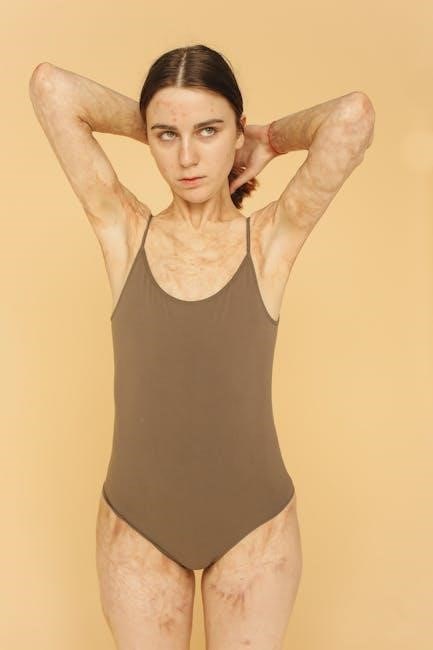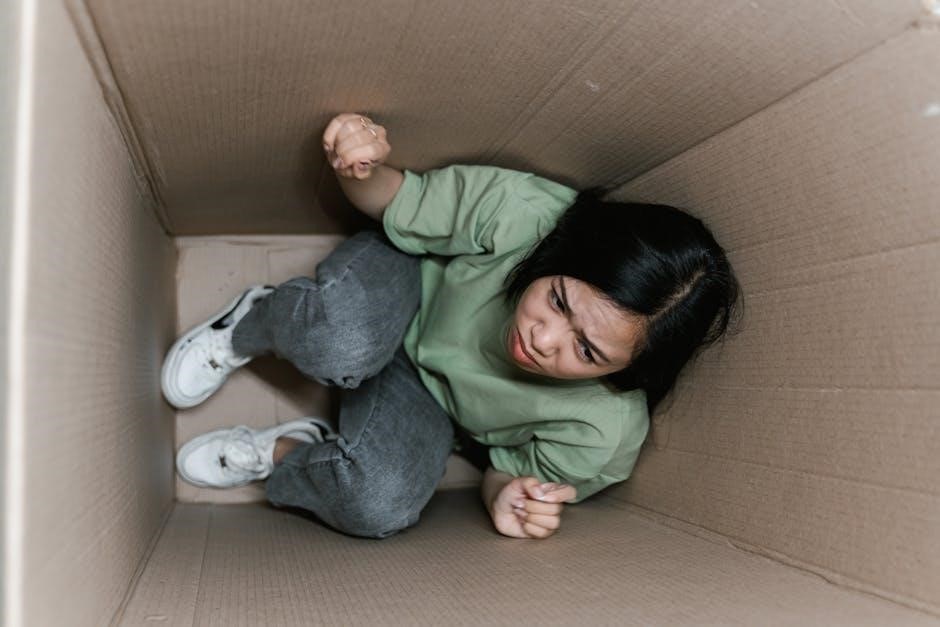Internalized homophobia refers to the absorption of societal homophobic attitudes, leading to self-shame and self-hatred among LGBTQ+ individuals, often causing mental health struggles and identity conflicts.
1.1 What is Internalized Homophobia?
Internalized homophobia is a psychological phenomenon where individuals from the LGBTQ+ community unconsciously adopt and internalize society’s homophobic attitudes and biases. This occurs when individuals are repeatedly exposed to negative messages about their sexual orientation, leading to self-doubt, shame, and self-hatred. It often develops during childhood and adolescence, when societal norms, family expectations, and cultural or religious teachings emphasize heterosexuality as the only acceptable orientation. As a result, many LGBTQ+ individuals struggle with feelings of inadequacy and may even reject their own identity. Internalized homophobia can manifest in self-destructive behaviors, difficulty in forming healthy relationships, or a fear of being discovered as gay. It is a deeply ingrained issue that requires self-awareness, acceptance, and support to overcome. Understanding this concept is crucial for addressing the mental health challenges it poses.
Understanding the Causes
Internalized homophobia arises from societal norms, family values, and religious beliefs that perpetuate negative attitudes, fostering self-shame and internal identity conflicts.
These influences shape self-perception and behavior, often unconsciously, leading to emotional distress and self-doubt.
Addressing these root causes is essential for healing and self-acceptance.
2.1 Societal Norms and Expectations
Societal norms and expectations play a significant role in the development of internalized homophobia. Many cultures perpetuate heteronormative ideals, portraying heterosexuality as the only acceptable orientation. This can lead individuals to view their same-sex attractions as abnormal or immoral, fostering feelings of shame and self-doubt. The constant exposure to homophobic stereotypes in media, workplace discrimination, and societal rejection further exacerbates these feelings. Growing up in environments where being LGBTQ+ is stigmatized can make individuals internalize these negative messages, believing they are lesser or unworthy. These societal pressures often result in a deep-seated conflict between their true identity and the expectations of others, contributing to mental health challenges and emotional distress. Addressing these societal influences is crucial for understanding and overcoming internalized homophobia.
2.2 Family and Upbringing
Family and upbringing significantly influence the development of internalized homophobia. Growing up in environments where LGBTQ+ identities are met with rejection or disapproval can deeply embed feelings of shame and self-hatred. Parents or caregivers who express homophobic views, whether explicitly or implicitly, often unintentionally convey that being queer is unacceptable. This rejection can lead to a sense of defectiveness or unworthiness. Additionally, being raised in conservative or religious households that emphasize traditional gender roles and heterosexual norms can exacerbate these feelings. The absence of open dialogue about sexuality and the lack of positive representation of LGBTQ+ individuals within the family further contribute to internalized homophobia. These early experiences shape self-perception and can lead to a lifelong struggle with self-acceptance, making it challenging to reconcile one’s true identity with the expectations of their upbringing.
2.3 Religious and Cultural Influences
Religious and cultural influences play a pivotal role in shaping internalized homophobia. Many religious teachings explicitly condemn same-sex attraction or non-heterosexual identities, fostering a sense of moral wrongdoing. Cultural norms often emphasize heterosexuality as the only acceptable orientation, leaving LGBTQ+ individuals feeling alienated and flawed. Growing up in societies where homosexuality is stigmatized or criminalized can intensify these feelings, as individuals internalize the negative messages surrounding their identity. Religious leaders and cultural figures frequently perpetuate homophobic attitudes, further entrenching self-hatred. The combination of spiritual condemnation and cultural rejection creates a toxic environment where LGBTQ+ individuals struggle to reconcile their faith or heritage with their true selves. This clash often results in profound emotional and psychological distress, making it difficult to embrace authenticity without feeling conflicted or ashamed.

The Emotional and Mental Health Impact
Internalized homophobia often leads to profound emotional distress, including shame, self-hatred, and low self-esteem, which can manifest as anxiety, depression, and self-destructive behaviors, severely impacting mental health.
3.1 Shame and Self-Hatred
Internalized homophobia often manifests as deep-seated shame and self-hatred, rooted in societal heterosexism and homophobic norms. Individuals may internalize negative messages, leading to a distorted self-image and self-loathing. This emotional burden can result in anxiety, depression, and self-destructive behaviors, as individuals struggle to reconcile their true selves with societal expectations. Shame may cause withdrawal from LGBTQ+ communities or hiding one’s identity, further exacerbating feelings of isolation. Self-hatred can also lead to self-sabotage in relationships or career goals, as individuals unconsciously perpetuate harmful beliefs about themselves. Overcoming these emotions requires acknowledging their origins and challenging internalized negativity through self-compassion and support systems. Without addressing these feelings, the long-term mental health consequences can be severe, making it essential to confront and heal from shame and self-hatred.
3.2 Behavioral Manifestations
Internalized homophobia can manifest behaviorally through self-destructive tendencies, such as substance abuse or self-sabotage, as individuals may unconsciously punish themselves for their sexual orientation. Some people may avoid forming intimate relationships or withdraw from LGBTQ+ communities, fearing rejection or judgment. Others might engage in hyper-conformity to societal norms, such as overemphasizing masculinity or heteronormative behaviors, to mask their true selves. In some cases, internalized homophobia leads to self-imposed limitations in careers or personal goals, as individuals may feel undeserving of success due to deep-seated shame. These behaviors often stem from the internalized belief that being LGBTQ+ is inherently wrong or inferior. Addressing these manifestations requires recognizing their roots in societal homophobia and actively working to dismantle harmful self-perceptions. By acknowledging and challenging these behaviors, individuals can begin to break free from the cycle of self-destructive patterns and embrace a more authentic, fulfilling life.

Strategies for Overcoming
Strategies include self-acceptance, challenging negative beliefs, building self-esteem, and practicing self-compassion to counteract internalized homophobia and foster emotional healing and authenticity.
4.1 Self-Acceptance
Self-acceptance is a critical step in overcoming internalized homophobia. It involves acknowledging and embracing one’s true identity, free from shame or judgment. Recognizing that internalized homophobic beliefs are rooted in societal norms rather than personal worthlessness is essential. By fostering self-compassion and challenging negative self-perceptions, individuals can begin to dismantle the harmful effects of internalized homophobia. Self-acceptance encourages individuals to value their authenticity and reject the internalized messages of inadequacy. It also involves understanding that sexual orientation is a natural part of human diversity. Through self-acceptance, individuals can reduce self-hatred, improve mental health, and build resilience against external homophobic attitudes. This process often requires patience, introspection, and support, but it is a powerful foundation for healing and living authentically.
4.2 Challenging Negative Beliefs
Challenging negative beliefs is a vital process in overcoming internalized homophobia. It involves identifying and questioning the harmful, ingrained attitudes that have been absorbed from societal, cultural, or familial sources. These beliefs often manifest as self-criticism, shame, or fear of rejection, stemming from internalized homophobic messages. To challenge them, individuals can engage in cognitive restructuring, replacing negative thoughts with affirming, realistic ones. Education about LGBTQ+ rights and experiences can also help dismantle misconceptions. Additionally, seeking guidance from therapists or support groups can provide tools to critically examine and reframe these beliefs. This process requires courage and patience, as it often involves confronting deeply rooted ideas. By actively challenging these beliefs, individuals can reduce their harmful impact and foster a more positive, accepting self-image.
4.3 Building Self-Esteem
Building self-esteem is a critical step in overcoming internalized homophobia. It involves cultivating a positive self-image and countering the harmful effects of societal and internalized negativity. Individuals can start by acknowledging their strengths and accomplishments, fostering self-worth through affirmations and self-compassion. Engaging in activities that bring joy and fulfillment can also enhance confidence. Surrounding oneself with supportive, affirming people and communities helps counteract the impact of homophobic messages. Additionally, practicing mindfulness and self-care can reinforce feelings of value and deservingness. Over time, these efforts can diminish the grip of internalized homophobia, allowing individuals to embrace their authentic selves with pride and resilience. Building self-esteem is a gradual process, but it is essential for achieving emotional well-being and living a fulfilling life free from shame.
4.4 Practicing Self-Compassion
Practicing self-compassion is a powerful tool for healing from internalized homophobia. It involves treating oneself with kindness, understanding, and patience, especially when confronted with feelings of shame or self-doubt. Self-compassion helps replace self-criticism with acceptance, fostering a healthier relationship with oneself. By acknowledging that everyone struggles and deserves care, individuals can begin to counteract the harmful effects of internalized homophobic messages. Mindfulness practices, such as journaling or meditation, can help cultivate self-compassion by encouraging non-judgmental awareness of one’s thoughts and emotions. Embracing self-compassion allows individuals to accept their authentic selves, reducing the grip of internalized homophobia and promoting emotional well-being. It is a vital step toward healing and living a life free from self-hatred and shame.

The Importance of Support

Support from professionals, communities, and allies is crucial for overcoming internalized homophobia, providing guidance, understanding, and acceptance that fosters healing and self-acceptance.
5.1 Professional Help
Seeking professional help is a vital step in addressing internalized homophobia. Mental health experts, such as therapists or counselors, can provide a safe, non-judgmental space to explore and reframe negative beliefs. They often use evidence-based therapies, like cognitive-behavioral therapy (CBT), to help individuals identify and challenge harmful self-perceptions. Trained professionals can also guide individuals through the process of self-acceptance and healing, offering tools to cope with shame and self-hatred. Support groups, either in-person or online, can further connect individuals with others who share similar experiences, fostering a sense of community and understanding. Additionally, professionals can help individuals develop strategies to navigate societal pressures and internalized biases, promoting emotional resilience and authenticity. With the right guidance, individuals can work toward reclaiming their identity and living a fulfilling, authentic life free from the weight of internalized homophobia.
5.2 Community and Allies
Building a strong support network within the LGBTQ+ community and among allies is crucial for overcoming internalized homophobia. Connecting with others who share similar experiences fosters a sense of belonging and reduces feelings of isolation. Support groups, both online and in-person, provide a platform to share stories, receive encouragement, and gain insights from others who have navigated similar challenges. Allies play a significant role by advocating for acceptance and creating inclusive environments. Their unwavering support can help counteract societal homophobia and empower individuals to embrace their true selves. Surrounding oneself with understanding and empathetic individuals can lead to greater self-acceptance and resilience. A supportive community serves as a reminder that one is not alone in their journey, offering validation and strength to overcome internalized shame and self-hatred.

Overcoming internalized homophobia is a journey marked by hope, resilience, and self-compassion. By addressing the root causes of shame and self-hatred, individuals can work towards healing and authenticity. Embracing a supportive community, seeking professional help, and practicing self-acceptance are essential steps in this process. Remember, healing is not a linear path but a continuous effort to challenge negative beliefs and build self-esteem. With patience and determination, individuals can transform their internalized homophobia into a source of strength, living a life free from the weight of societal expectations. The journey towards healing is not solitary; it is supported by understanding allies and a compassionate community. Ultimately, hope and self-love guide the path to true liberation and mental well-being.
